Soesterberg Royal Netherlands Air Force Base
| Soesterberg Air Base Camp New Amsterdam | |||
|---|---|---|---|
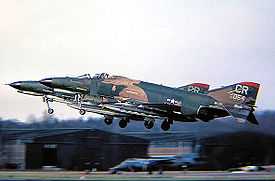 | |||
| F-4E Phantom II of 32nd TFS taking off, about 1975, at Soesterberg Air Base | |||
| IATA: UTC – ICAO: EHSB | |||
| Summary | |||
| Airport type | Military Closed since 2008 | ||
| Owner | Military of the Netherlands | ||
| Operator | Royal Netherlands Air Force (RNLAF) Koninklijke Luchtmacht (KLu) | ||
| Location | Soesterberg, Netherlands | ||
| Elevation AMSL | 20 m / 66 ft | ||
| Coordinates | 52°8′3″N 5°16′59″E / 52.13417°N 5.28306°E | ||
| Runways | |||
| Direction | Length | Surface | |
| m | ft | ||
| 09/27 | 3,075 | 10,089 | Asphalt |
| Source: DAFIF[1][2] | |||
Soesterberg Air Base (IATA: UTC, ICAO: EHSB) was a Royal Netherlands Air Force military airbase located in Soesterberg, 14 kilometres (8.7 mi) east-northeast of Utrecht. It was first established as an airfield in 1911, and in 1913, the Dutch Army bought the field and established the Army Aviation Division.
For almost 40 years, United States Air Force facilities at Soesterberg, named Camp New Amsterdam was a major front line USAFE airbase during the Cold War. The base was closed on 31 December 2008, due to budget cuts in the Dutch Army. The airbase ceased flying operations on 12 November 2008, when the command was transferred from the Dutch Air Force to Dutch Defense who will take care of the base until it will be given back to nature. The last fighter ever to depart, delayed due bad weather at Aviano AB, was a Greek F-4E. The former USAFE part stays in military hands, and will now officially be called Camp New Amsterdam.
Early history
During World War I, the Netherlands was a neutral country, and flew border patrol missions from Soesterberg airfield. The Dutch confiscated all foreign aircraft landing inside the borders of their country during the war, and added the operational ones to their inventory to be used for pilot training at Soesterberg.
At the beginning of World War II, the Dutch again declared neutrality, but the German force's blitzkrieg overran the country in five days, and Soesterberg was occupied by the German Luftwaffe on 15 May 1940. A variety of German aircraft was stationed there during the war, flying anti-shipping missions along British convoy routes in the North Sea, bombing missions over England, and fighter defence against Allied bombing missions. Throughout the war, Allied Air Forces caused enormous damage to the airfield, and by September 1944 the Luftwaffe acknowledged Soesterberg airfield to be more or less useless.
In May 1945, Canadian forces liberated the airfield. After the War, an extensive Dutch construction programme was started[3] - to build, new hangars, extending the runways and several locations around the base, used as service areas during the War, were upgraded. On 5 August 1951, the Royal Netherlands Air Force (RNLAF) declared it operational and gave it an air defence role. The RNLAF has maintained flying units at Soesterberg since then.
On the base two monuments were erected. The monument for Fallen Aviators (Monument voor Gevallen Vliegers) is the official Royal Netherlands Air Force Memorial, and located near the main entrance of the base. On Memorial Day, 4 May the Royal Netherlands Air Force holds a ceremony to remember and commemorate the fallen of World War II.
The other monument at the base is for Executed Resistance Fighters. It is the symbol for the sacrifice that 33 resistance fighters gave for freedom. Every year on 19 November, there is a memorial service. During World War II, the German Army (Wehrmacht) secretly executed the 33 resistance fighters in the woods of the base. The resistance fighters were part of several resistance groups and most of them were caught due to betrayal. Although the execution was held in secret, there were rumours about it, and after the War the base was minutely searched. The mass grave, camouflaged by buried trees, was located by Major A. Siedenburg. His son was one of the victims.
USAF use
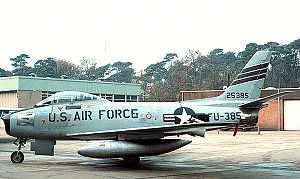
In 1954, the Dutch government agreed to the stationing of a US Air Force fighter squadron to augment air defence. The USAF forces operated from a part of Soesterberg Air Base which was named Camp New Amsterdam, in honour of the first Dutch settlement in America, Nieuw Amsterdam, later renamed New York City.[3]
512th Fighter-Day Squadron
The first U.S. Air Forces in Europe (USAFE) unit to operate from Soesterberg was the 512th Fighter-Day Squadron, which arrived with North American F-86F "Sabre" on 16 November 1954 from RAF Manston in the UK.[3] By July 1955, the 512th reached full operational status. The squadron markings of the F-86s were with three green bands at the vertical tail.
It was a tradition in the U.S. Air Force that a squadron, which was stationed in a foreign country, have a historical tie with it. Because the 512th had no historical ties with the Netherlands, the Americans started a search for their traditional historical link between the two countries. It was found that the World War II 32d Fighter Squadron had been stationed on the Dutch islands Curaçao and Aruba in the Caribbean Sea, which then gave the squadron its historical ties.
32d Fighter-Interceptor Squadron
In September 1955, the designation of the 512th was transferred to RAF Shepherds Grove, where it replaced the 78th FIS. Its aircraft, personnel and equipment however stayed in the Netherlands, and made up the newly activated 32d Fighter Day Squadron, which was operated at Soesterberg as a detachment of the 36th Fighter Wing at Bitburg Air Base West Germany.[3][4]
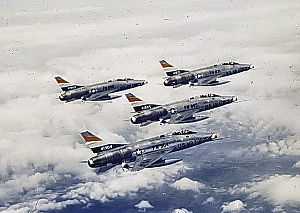
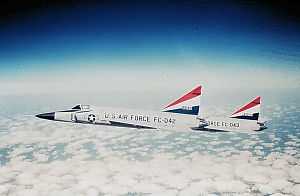

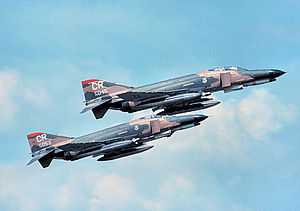
In 1956, the squadron transitioned to North American F-100 "Super Sabres".[3] The 32d sent five instructors pilots to Sidi Slimane AB in Morocco to complete transition training for the F-100. At the same time, the squadron began ferrying the F-86s to Prestwick, Scotland, and Châteauroux-Déols Air Base in France for disposal. On 18 July 1958, USAFE redesignated the unit as the 32d Tactical Fighter Squadron, as part of the 36th Tactical Fighter Wing.[3]
Due the requirement of a longer runway for landing and take offs, the runway of the base was extended to over 3,000 metres (9,840 ft).[3] In 1957, the squadron’s operational strength was increased to 24 aircraft.
In 1959, the 32d received the signature "Royal", the crown and wreath of the Dutch Royal Family (the House of Orange) were added to the emblem, giving it its unique look. This unique honour was granted in recognition of the unit's contribution to the defence of the Netherlands, and graphically illustrates the 32d's close ties with the Royal Netherlands Air Force. The 32 TFS had the unique distinction of being the only unit in the USAF whose emblem included the royal crest of another nation. This addition was only authorised as long as the 32d TFS remained in the Netherlands.
In January 1959, the 525th Fighter Interceptor Squadron at Bitburg received the first Convair F-102 "Delta Dagger", designed to upgrade the air defence capabilities of Western Europe. As part of this upgrade, the 32d was redesignated as the 32d Fighter Interceptor Squadron,[3] and also received F-102s[3] and acquired a 24-hour alert commitment flying alert interceptor mission from Soesterberg supporting NATO’s Second Allied Tactical Air Force (2d ATAF). The 32 FIS was assigned to the USAFE 86th Air Division (Defense) at Ramstein Air Base West Germany on 1 July 1960. This transfer was made in order that all USAF fighter assets in Europe could be concentrated in one command.
The 32d flew 18 F-102s, with the aircraft, were divided into three flights red, white and blue. Through the years, the markings were altered several times. From a red-white-blue tailplane, red-white and blue flaps and a green band on, again, the tailplane into a green/brown camouflage painting.
32nd Tactical Fighter Squadron
As a result of the 1968 Soviet intervention in Czechoslovakia, the USAF announced that its F-102 squadrons would be re-equipped with the modern McDonnell Douglas F-4 "Phantom II". The 32nd squadron was first in line to undergo the conversion, and the F-102s were flown back to the United States and were placed in service with the Air National Guard.
On 1 July 1969, the USAF redesignated the unit as the 32nd Tactical Fighter Squadron (32nd TFS).[3] On 6 August 1969, the first two, brand new, Phantoms arrived. Flying the F-4 Phantom meant some drastic changes for the squadron and the base. Personnel had to be increased, and the squadron's task was extended to include lending air support to ground troops. Also, USAFE wanted to upgrade the headquarters element of the 32d to group status, and establish itself as a separate organisation from the 36th TFW at Bitburg. However, the Dutch and American governments had agreed that the US Air Force would only station a "squadron" at Soesterberg, and this fact hindered the American attempt to upgrade the squadron's status.
Also in 1969, the USAF decided to assign the 32nd with the "CR" tailcode. During the Vietnam War, it was found that a camouflaged aircraft was hard to identify. That was why the tailcode concept was introduced. The tails of 32d TFS's F-4s were also provided with a green and orange band (green being the squadrons' color and orange of the Royal House of Orange).
In 1978, the F-4s were flown to Ramstein Air Base in Germany, where they were assigned to the 86th TFW. The 32d was upgraded to the McDonnell Douglas F-15A "Eagle" as part of Project Ready Eagle which brought F-15s to Bitburg in 1977. However, after flying the F-15A and F-15B for just 18 months, the USAF exchanged these models for the new F-15C and F-15D Eagles.
In May 1980, the 32d flew five of its Eagles to Eglin Air Force Base Florida, to participate in the weapons systems evaluation program. While at Eglin, the unit swapped its aircraft for the newer models. These planes arrived at Soesterberg on 13 June, making the 32nd the first unit in the USAFE to be equipped with the latest versions of the F-15. The 32nd completed the upgrade on 25 November 1980. At that time, the squadron possessed 18 F-15Cs and two F-15Ds fighter aircraft.
In 1989, the Dutch government allowed USAF to upgrade its headquarters unit at Soesterberg AB from squadron to group status. The 32d Tactical Fighter Group was activated at Soesterberg on 16 November 1989, with the 32 Tactical Fighter Squadron as a subordinate unit and much reduced in size.
During the 1991 Gulf War, after more than forty years, the 32d saw combat. Aircrew and ground support personnel were deployed, during the operations DESERT SHIELD and DESERT STORM at Incirlik Air Base, Turkey. On 28 January 1991, one of the team members actually killed an Iraqi MiG. After the War they continued their air activities in theatre as a part of operation PROVIDE COMFORT from April 1991 until April 1993.
In November 1991, with the force structure reorganization, both units dropped tactical from their name. In the fall of 1991, the 32d became fully equipped with F-15C/D Multi-Stage Improvement Program (MSIP) Eagles.
Dutch use
On the Dutch side, the airfield was used by 334th squadron flying the venerable Fokker F.27 beginning in 1968, and by the 298th squadron flying the SA 316 since 1969. In August 1981 however, the 336th squadron was reborn at Soesterberg. The task this time: Patrolling the skies over and around the islands of the Netherlands Antilles in the Caribbean. For the job, two new Fokker F.27 Mk.200 Maritime Patrol Aircraft were ordered. In September 1981, the first aircraft was delivered to the Royal Netherlands Air Force, and received the registration M-1. This aircraft departed to Curaçao in early November 1981, and the first pilot was Mayor G.W.G.F. Rijnders. The aircraft arrived on the island on 13 November 1981. The second Maritime registered M-2 arrived in March 1982. In 1992 the 334th squadron moved to Eindhoven Airport. With this departure, the 298th squadron was the only flying unit at the base until 1995, when the 300rd squadron joined the 298th squadron. In the same year, the 298th squadron converted to the CH-47 Chinook, and passed the SA 316 to Gilze-Rijen Air Base, while the 300th squadron received the AS 532 U2 Cougar. Later the SA 316 returned to Soesterberg and joined 300th Squadron.
USAF departure
With the end of the Cold War, a major force draw-down occurred in Europe, the USAF reduced its fighter force structure. These changes affected the 32nd, as part of the draw-down, the squadron's F-15 Eagles returned to the United States. The original intent of USAFE was to inactivate the 32d Fighter Group, and orders were so issued inactivating the group's subordinate units on 1 July 1994[5] and the group on 1 October.
On 19 April, the group furled its colors in formal ceremonies attended by members of the Royal Family, and the American ambassador. Later in the spring, however, HQ USAFE received permission from HQ USAF to use the 32d designation for the new 32d Air Operations Group. HQ USAFE created this unit on 1 July, and activated the 632d Air Base Squadron the same day to replace the 32d Fighter Group at Soesterberg to complete closure actions. The same order redesignated the group's 32d Fighter Squadron as the 32d Air Operations Squadron, with assignment to the 32d Air Operations Group. All actions were effective 1 July 1994.
In this way, USAFE was able to preserve the lineage of these two distinguished units. The American part of Soesterberg was returned to the Netherlands government on 27 September 1994. Only one F-15A remains in the Netherlands, and is displayed at the Military Aviation Museum.[6] Soesterberg then became a Royal Netherlands Air Force transport helicopter base with 298th squadron (CH-47 Chinook) and 300th squadron (AS 532 U2 Cougar and SA 316) stationed at the base.
Flying officially ended on 12 November 2008. The last jet ever to take off was a Hellenic AF F-4E. The base formally closed on 31 December 2008. The 298th and 300th squadron have been moved to Gilze-Rijen Air Base. A part of the base remains in use as a glider field however. Also, the former USAFE side will be in use by ground units and will be called "Camp New Amsterdam". Finally, the AF museum returned to the base and will use most of the existing hangars.
See also
- The Netherlands in World War II
- United States Air Forces in Europe
References
- ↑ Airport information for EHSB at World Aero Data. Data current as of October 2006.Source: DAFIF.
- ↑ Airport information for UTC at Great Circle Mapper. Source: DAFIF (effective Oct. 2006).
- ↑ 3.0 3.1 3.2 3.3 3.4 3.5 3.6 3.7 3.8 3.9 Fletcher, Harry R. (1989). Air Force Bases Volume II, Active Air Force Bases outside the United States of America on 17 September 1982. Maxwell AFB, Alabama: Office of Air Force History. pp. 19–20. ISBN 0-912799-53-6.
- ↑ Ravenstein, Charles A. (1984). Air Force Combat Wings Lineage and Honors Histories 1947-1977. Maxwell AFB, Alabama: Office of Air Force History. p. 64. ISBN 0-912799-12-9.
- ↑ "Lineage data of the 32nd Wolfhounds". Slobberin' Wolfhounds. Archived from the original on 2010-03-04.
- ↑ "Militaire Luchtvaart Museum | English". Militaireluchtvaartmuseum.nl. Retrieved 2011-11-15.
- Endicott, Judy G. (1999). Active Air Force wings as of 1 October 1995; USAF active flying, space, and missile squadrons as of 1 October 1995 (CD-ROM). Maxwell AFB, Alabama: Office of Air Force History.
- Rogers, Brian (2005). United States Air Force Unit Designations Since 1978. Hinkley, England: Midland Publications. ISBN 1-85780-197-0.
- USAAS-USAAC-USAAF-USAF Aircraft Serial Numbers—1908 to present
- Awards: AFP 900-2 and AFPAM 36-2801
External links
- "Slobberin' Wolfhounds". Archived from the original on 2010-02-22.
- Soesterberg Wolfhounds
- F-4 Phantoms
- Airliners.net - Photos taken at Soesterberg Air Base
- Accident history for UTC at Aviation Safety Network
| ||||||||||||||||||||